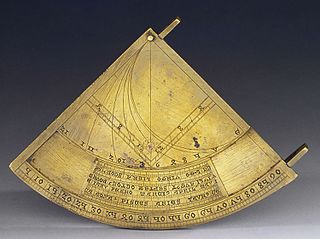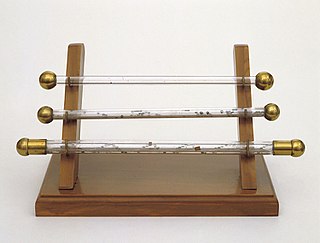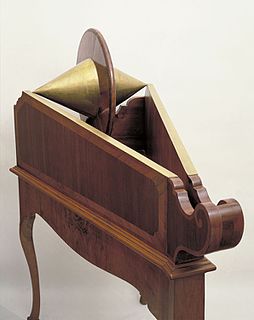
Sidereus Nuncius is a short astronomical treatise published in New Latin by Galileo Galilei on March 13, 1610. It was the first published scientific work based on observations made through a telescope, and it contains the results of Galileo's early observations of the imperfect and mountainous Moon, the hundreds of stars that were unable to be seen in either the Milky Way or certain constellations with the naked eye, and the Medicean Stars that appeared to be circling Jupiter.

A refracting telescope is a type of optical telescope that uses a lens as its objective to form an image. The refracting telescope design was originally used in spyglasses and astronomical telescopes but is also used for long-focus camera lenses. Although large refracting telescopes were very popular in the second half of the 19th century, for most research purposes, the refracting telescope has been superseded by the reflecting telescope, which allows larger apertures. A refractor's magnification is calculated by dividing the focal length of the objective lens by that of the eyepiece.

Museo Galileo, the former Istituto e Museo di Storia della Scienza is located in Florence, Italy, in Piazza dei Giudici, along the River Arno and close to the Uffizi Gallery. The museum, dedicated to astronomer and scientist Galileo Galilei, is housed in Palazzo Castellani, an 11th-century building which was then known as the Castello d’Altafronte.

An aerial telescope is a type of very long focal length refracting telescope, built in the second half of the 17th century, that did not use a tube. Instead, the objective was mounted on a pole, tree, tower, building or other structure on a swivel ball-joint. The observer stood on the ground and held the eyepiece, which was connected to the objective by a string or connecting rod. By holding the string tight and maneuvering the eyepiece, the observer could aim the telescope at objects in the sky. The idea for this type of telescope may have originated in the late 17th century with the Dutch mathematician, astronomer and physicist Christiaan Huygens and his brother Constantijn Huygens, Jr., though it is not clear if they actually invented it.

The Tribune of Galileo is a Neoclassic architectural addition, built to commemorate the famous Florentine scientist, Galileo Galilei and to house some of his scientific instruments.

The Old Fortress of Livorno is a castle in Livorno, Italy. The Old Fortress is a successor building to a medieval fort built by the city of Pisa in the location of an older keep built by Countess Matilda of Tuscany in the 11th century. The 11th century tower was incorporated inside the fort built by the Pisans. The castle has been described as a "symbol of Medicean Livorno". The fort is located at the Medicean Darsena, or old dock of the port of Livorno, built by the Medici family. The ceremony proclaiming Livorno a city took place inside the fortress on 19 March 1606.

The writing hand is a mechanical automaton created by Friedrich von Knauss in 1764. A clockwork mechanism moves a hand which dips a pen into an inkstand and writes the phrase "Huic Domui Deus / Nec metas rerum / Nec tempora ponat" on a small card. On the silver-coating of the mechanism are the words "Pro patria".

Vittorio Crosten was an able carver of Dutch origin.

The jovilabe is a brass scientific instrument, undated and of unknown maker, currently in the collection of the Museo Galileo in Florence, Italy.
The Campani compound microscope is a microscope on exhibit at the Museo Galileo in Italy, thought to have been built by optical instrument maker Giuseppe Campani in the second half 17th century. For a time it was thought to have been built by Italian scientist Galileo Galilei but no longer bares that attribution.

The thunder house is a scientific model invented by James Lind which gives a spectacular demonstration of the destructive effect of a lightning bolt striking a house with an imperfect lightning conductor.

The Quadrans Vetus is a medieval astronomical instrument.

The Instrument of the Primum Mobile is also called the quadrant of Petrus Apianus, because he invented it and described it in the treatise Instrumentum primi mobilis. The instrument is used to find sines and cosines. It bears the initials "F.E.D.P.F." [Frater Egnatius Dantis Predicatorum Fecit]. Ignazio Danti dedicated it to Cosimo I de' Medici, as attested by the Medici coat of arms engraved on the front. The instrument was depicted on the ceiling of the Stanzino delle Matematiche in the Uffizi Gallery.

The Tabula Affinitatum is a table of chemical affinities between substances.

The tall-stem thermometers are a kind of thermometer, resting on branched feet.

The frog thermometer or - as the Cimento academicians defined it, the botticino [small-toad] thermometer - contained small glass spheres of different density, which were immersed in alcohol. The device was used as a clinical thermometer, tied to the wrist or the arm of the patient with the head of the frog facing upward. The variations in body temperature were registered by the movement of the spheres. The rise in temperature causes an increase in the volume of the alcohol, reflected in the movement of the small spheres. Because of the spheres' sluggish motion, this thermometer was also called infingardo [slothful, slow]. The invention of this model is attributed to Ferdinand II de' Medici.

The luminous discharge tube is part of an electric machine.

The elastic and inelastic collisions apparatus is a large apparatus to study elastic and inelastic collisions.

The mechanical paradox is an apparatus for studying physical paradoxes. It consists of a trapezoidal veneered wooden frame with two brass rails, and a pair of brass cones joined at their bases by a wooden disk which rests on the rails. When the double cone is placed at the low end of the frame, it automatically starts to roll upward, giving the impression of escaping the universal law of the gravitational force.

The Reale Museo di Fisica e Storia Naturale was an Italian museum founded on 22 February 1775 in Florence that survived until 1878, when its collections were split up in various Florentine museums.




















